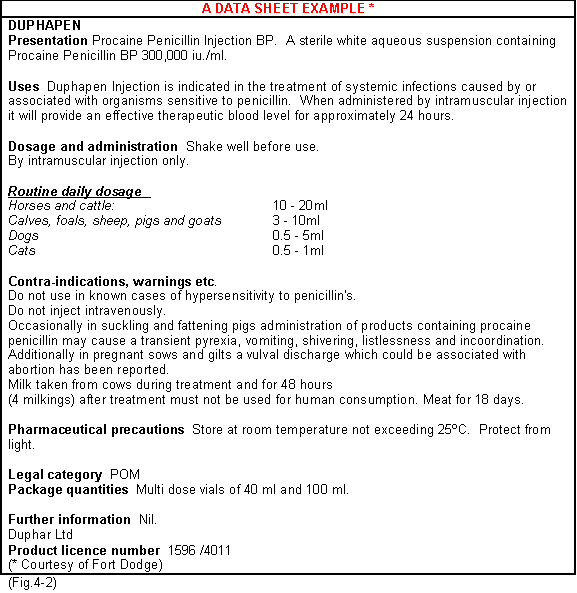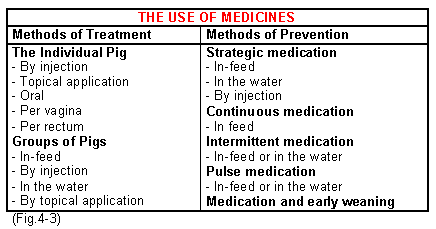



Types of medicine and their application
Medicines used in the swine industry can be grouped into eight broad areas:-
- Antibiotics and antibacterial substances.
- Minerals, for example iron, vitamins and electrolytes.
- Sedatives and analgesics (painkillers).
- Parasecticides to treat mange, lice and worms.
- Vaccines and sera (and miscellaneous medicines).
- Hormones.
- Growth promoters and probiotics.
- Colostrum supplements.
For each individual medicament a manufacturers data sheet will be available, which gives guidelines as to its use, specific precautions and any contra-indications.

Medicines can be administered to individual pigs or groups of pigs for treatment or to prevent disease.
Individual treatments are usually given by mouth in the case of piglets, by injection in older pigs and occasionally onto the skin or per vagina. In outbreaks of disease, group treatments are carried out by in-feed medication, injections or in the water. Treatment for mange or lice may involve the use of sprays. Where medicines are used to prevent disease, they can be used in a number of ways as illustrated in Fig.4-3. The most efficient and cost-effective method of treatment is to administer medicines, either by injection or by mouth, to the individual pig. Sick animals do not eat much, and contrary to popular opinion, they do not drink much either. In outbreaks of disease therefore the treatment of sick pigs in the feed or water is not medically efficient. Furthermore in a group of pigs affected with pneumonia for example, it is unlikely that more than 20% of such animals have sufficient lesions to require treatment and 80% of the group would therefore be treated unnecessarily. This cost must be added to that of the sick 20%. However group medication can be of value in preventing more disease developing. There can be practical problems with treating large numbers of individual pigs. Nevertheless, the response is much better.

Medicines are administered in a variety of ways depending on the type of medicine and its availability. Some medicines are toxic by injection and may only be available by mouth, whereas others may be applied and absorbed through the skin. It takes a period of time for any medicine to be absorbed into the system to reach levels sufficient to have a therapeutic effect and then be excreted from the body. The frequency of treatment is determined using this knowledge.
The following methods of administration are used in the pig :-
By injection - Intravenous, subcutaneous, intradermal and intramuscular.
Topical - The medicine is applied to the surface of the body. An example would be the use of pour-on organophosphorus preparations or sprays for the control of mange.
Oral - Most injectable antibiotics are also available for oral administration.
Via the Uterus - Pessaries (small slow-melting tablets) can be placed into the uterus following interference at farrowing. Likewise, antibiotics can be deposited into the anterior vagina in cases of infection.
Via the Rectum - This is not a normal method for administrations in the pig, although in cases of meningitis associated with salt poisoning and water deprivation, water can be dripped into the rectum to correct the imbalance. (See chapter 15 Flutter valve)
The method of administration will be indicated on the label of the bottle, and this should always be followed. For example, intravenous injections are used for anaesthesia, intradermal injections to test animals for tuberculosis, and subcutaneous injections for certain types of antibiotics or some vaccines. The most common route of injection however is intramuscular for antibiotics, iron injections, and oil-based vaccines. Occasionally, injections might be given into the joint for arthritis or into the mammary glands for mastitis.







